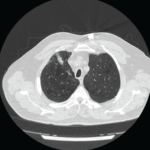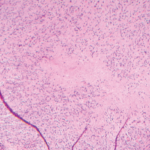B. Psoriasis: Psoriasis is a common, chronic inflammatory skin disease typified by sharply marginated, erythematous plaques with a distinctive silver-white (“micaceous”) scale exhibiting a predilection for extensor surfaces including the elbows and knees, the scalp, presacrum and the nails. Arthritis accompanies skin disease in approximately 10–20% of cases and is more common in the setting of severe skin involvement. The location of the lesions in this case, together with overlying scale and inflammatory arthritis, may have initially suggested a psoriatic lesion, but the morphologic and histopathologic distinctions would make psoriasis unlikely. Unlike PNGD, psoriasis does not crust or umbilicate, but lesions of psoriasis may occasionally develop pustules, particularly in the acute or pustular forms of disease. The histopathologic appearance of psoriasis notably lacks a granulomatous component.
Palisaded neutrophilic & granulomatous dermatitis (PNGD) is an uncommon inflammatory dermatosis characterized by discrete skin-colored to erythematous papules that appear symmetrically on the extensor aspects of the extremities with a tendency to cluster around the small joints of the hands & elbows.
D. Perforating granuloma annulare: Granuloma annulare (GA) is an idiopathic, non-infectious granulomatous dermatitis that classically presents with small, nondescript erythematous papules that coalesce into arciform and annular plaques. Granuloma annulare often affects younger patients and develops on the hands, arms, legs and, less often, the trunk. Because of its annular configuration, GA is frequently mistaken for a superficial dermatophyte infection of the skin, but granuloma annulare’s characteristic red-brown color that accentuates with diascopy and its notable absence of scale serve as distinguishing features.
Perforating GA is an uncommon variant that displays central umbilication or focal ulceration, which corresponds to transepidermal elimination of degenerated collagen seen by histopathologic assessment. Although clinically reminiscent of PNGD, perforating GA lacks neutrophils and contains abundant mucin on histology. The overwhelming majority of cases of GA are primary or idiopathic; very rarely, atypical forms of GA have been reported in association with solid tumors and lymphomas. Whether or not a true association between generalized GA and diabetes mellitus exists is a matter of controversy.
E. Erythema elevatum diutinum: Erythema elevatum diutinum (EED) is an uncommon, small vessel vasculitis of the skin that is best regarded as a reactive neutrophilic disease. It presents with symmetrically distributed red to brown papules and plaques that favor the periarticular skin of the hands, elbows, knees and ankles. Lesions often appear non-specific and fail to develop secondary features such as crust formation or umbilication.

